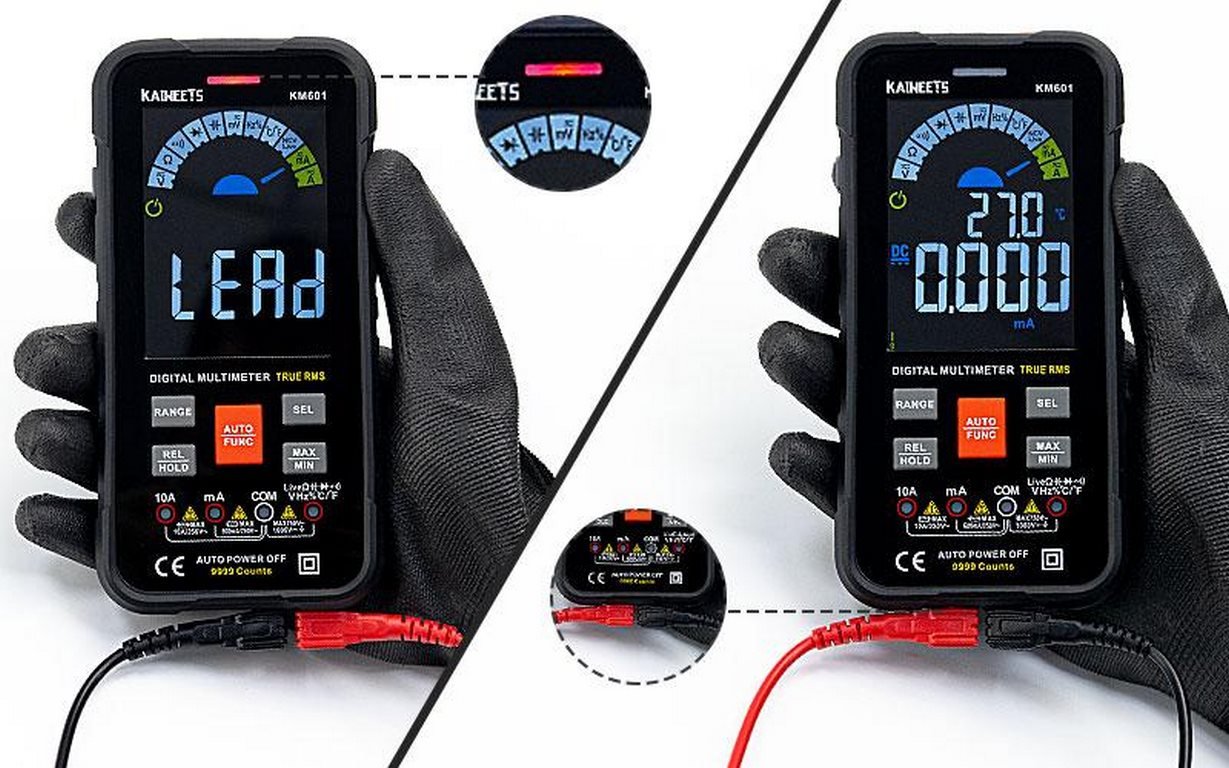Table of Contents Show
How many volts are there? And how many amps flow? When using everyday devices, we normally do not have to ask ourselves these questions. Adapters and power supplies do the thinking.

But even with small electrical work, you can no longer avoid taking a closer look at the current – or better said – the multimeter. But what can you measure with the smart multimeter?
What should you watch out for when measuring? Here you can find out how you can easily find out about the current.
What is a Multimeter?
A multimeter is a measuring cup, the ruler, and the scales of electrical engineering at the same time: It is a universally applicable measuring device with which various electrical quantities can be measured.
That is why one sometimes speaks of a multimeter. Multimeters are available in different designs and from numerous different manufacturers.
A basic distinction is made between analog multimeters (AMM) and digital multimeters (DMM). With the former, the measured value can be read off on a scale, while digital multimeters show the measured value on an LCD display. You can try KM601 Digital Multimeter for smart measuring.
What Can You Measure with the Multimeter?
A multimeter can always measure at least three electrical parameters:
- Amperage (I) in amperes (A)
- Voltage (U) in volts (V)
- Resistance (R) in Ohm (Ω)
With the currents and voltages, direct and alternating voltages or direct and alternating currents can be measured. The multimeter calculates the resistance value from the voltage or current, depending on how it works.
Read Also:
How Do You Measure with A Multimeter?
Even if a multimeter can appear complicated at first glance, the measuring device can be understood quickly on closer inspection.
The most important parts of a multimeter include:
- Display (digital) or scale (analog) for reading the measured values
- Rotary switch for the measuring range: for selecting the functions
- Measuring ranges for the respective measured variables
- Test sockets for connecting the test probes
- Test leads/test probes (red and black) for establishing a connection between the sockets and the test object
What Should You Watch Out for When Using a Multimeter?
The most important thing about a multimeter is to make the correct settings before measuring. Both analog and digital multimeters usually have around rotary switch in the middle, which can be used to make the following settings, among others:
- Measurand
- Measuring range
The measurement variable of the multimeter can be easily adjusted. In the end, it’s all about knowing what you want to measure: DC stands for direct voltage, AC for alternating voltage or V stands for volts (voltage), and A for amperes (current strength). If the resistance is to be measured, it must be selected with the symbol Ω for ohms.
Set the Measuring Range on the Multimeter
Anyone who tries to measure a few milliliters with a water barrel will find it difficult to obtain an exact result. And if you try to pour several liters of water into a shot glass, you will only get a flood, but no precise measurement results either. The situation is similar to the measuring range of the multimeter.
While more modern models have a so-called auto-range function, through which the multimeter automatically determines the measuring range, on some models the measuring range has to be set manually.
And since the exact value still has to be measured, it is important to estimate the expected measuring range.
If it is difficult to estimate, in case of doubt it is always better to choose a measuring range that is too large and “feel your way” to the appropriate area. When measuring, you switch down from a large level step by step until an exact measurement result is displayed.
This can be illustrated again using the example of water: If you have an opaque water canister and do not know exactly how much water it contains, you first choose a large container to fill the water with.
If the vessel is still too big, you can use a smaller one, etc., until you can finally determine the amount of water as best as possible.
How Do You Measure the Voltage (U) with A Multimeter?
Once you are familiar with the components and functions of the multimeter, you can finally start measuring. Let’s start with one of the simplest measurements: the voltage measurement.
Since the voltage in the parallel connection is the same everywhere, the multimeter can simply be connected in parallel to the object to be measured or the voltage source.
How to measure the voltage with the multimeter:
- Use the rotary switch to select the appropriate measuring range (V for volts).
- When in doubt, remember to first select a coarser measuring range to be on the safe side.
- Plug the black measuring cable into the COM socket and the red measuring cable into the V socket.
- Hold the test probes at the points between which you want to measure the voltage. How to measure parallel to the measuring object.
How Do You Measure the Current (I) With A Multimeter?
The current measurement with the multimeter, in contrast to the voltage measurement, requires some preliminary work. Since the current intensity is the same in a series connection (and not in a parallel connection), the multimeter must be connected in series and the circuit must be separated.
How to measure the amperage with the multimeter :
- Set the rotary switch to A for amps (the unit of current).
- A distinction must be made between alternating current (AC) and direct current (DC). The type of current can usually be deduced from the application. For example, batteries operate on direct current, while household electricity is alternating current.
- Plug the black measuring cable into the COM socket and the red measuring cable into the socket labeled with an A.
- This socket is specially designed for current measurement.
- Fluke alligator clip set
- Create two measuring points by disconnecting the circuit.
- Make sure that no power supply is connected; the circuit to be measured must be voltage-free for the separation.
- Make sure the circuit is connected to a power supply.
- Hold the test probes against the points on the circuit.
- If you have to carry out the measurement on connecting wires, so-called alligator clips can be used instead of test probes. These can be conveniently clamped to the wires.
How Do You Measure the Resistance (R) of A Circuit with A Multimeter?
The resistance measurement with a multimeter works a little differently than the voltage and current. In fact, the multimeter does not measure the resistance at all but calculates it using Ohm’s law (resistance R = voltage U / current I).
To do this, the multimeter sends a small measuring current through the resistor and determines its size based on the associated voltage drop. The multimeter’s battery serves as the voltage source.
How to measure the resistance with the multimeter:
- Set the rotary switch to the ohm symbol (Ω).
- Plug the black measuring cable into the COM socket and plug the red measuring cable into the socket with the Ω for ohm.
- Make sure that the circuit is voltage-free, i.e. not being supplied with energy.
- Hold the two test probes at the points between which the resistance is to be measured.
Conclusion
Admittedly, a multimeter can seem a bit complicated at first. But once you get the hang of it, it quickly becomes your favorite measuring device. Quite simply because it can be used universally and you can determine several measured variables with a multimeter.
In addition to the three typical measured variables of current, voltage, and ohmic resistance, modern models also measure frequencies, capacities, continuity, and much more.
The measurement result can be read off particularly conveniently with digital versions and with the Auto Range function you even have to avoid choosing the correct measuring range.
However, there are always a few aspects that need to be considered. Above all, you should be familiar with the peculiarities of the respective measured variables. Because if you measure the voltage in series and the current in parallel, you will see confusing results.
Pay a little attention to your multimeter, the polarity, and the measured variables, you can measure all the key figures of a circuit with your all-rounder. With a multimeter, there are no more secrets between you and your circuits.










